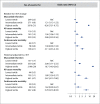Using historical cardiac troponins to identify patients at a high risk of myocardial infarction
- PMID: 35948410
- PMCID: PMC9811078
- DOI: 10.1136/heartjnl-2022-321198
Using historical cardiac troponins to identify patients at a high risk of myocardial infarction
Abstract
Objective: Many patients who present with chest pain have previous measurements of high-sensitivity cardiac troponin T (hs-cTnT). The clinical usefulness of incorporating these measurements in identifying patients who are at a high risk of myocardial infarction (MI) is unknown. We investigated if the relative change between a historical hs-cTnT and the admission hs-cTnT could improve early identification of patients with a high risk of MI.
Methods: We included all patients presenting with chest pain to seven different emergency departments (EDs) in Sweden from December 2009 to December 2016, who had at least one hs-cTnT measurement at the presentation and at least one available prior measurement. We used logistic regression to investigate the diagnostic performance of using various combinations of current and historical hs-cTnT measurements in diagnosing MI within 30 days.
Results: A total of 27 809 visits were included, among whom 2686 (9.7%) had an MI within 30 days. A cut-off value for historical hs-cTnT-adjusted admission hs-cTnT with similar specificity (91.2%) as an admission hs-cTnT of ≥52 ng/L identified 4% more MIs (43% vs 39%) and had a higher positive predictive value, 42.6% (95% CI, 41.0% to 44.3%) vs 38.9% (95% CI 37.4% to 40.4%), as well as a higher positive likelihood ratio, 6.95 (95% CI 6.69 to 7.22) vs 5.95 (95% CI 5.73 to 6.18). Among patients with an admission hs-cTnT of <52 ng/L who were classified as high-risk patients when incorporating past hs-cTnT measurements, 28% suffered an MI.
Conclusions: Historical hs-cTnT levels can be used with admission hs-cTnT to improve early risk stratification of MI in the ED.
Keywords: Biomarkers; Chest Pain; Epidemiology; Myocardial Infarction.
© Author(s) (or their employer(s)) 2023. Re-use permitted under CC BY-NC. No commercial re-use. See rights and permissions. Published by BMJ.
Conflict of interest statement
Competing interests: None declared.
Figures




Comment in
-
Historical cardiac troponin concentrations in patients with suspected acute coronary syndrome.Heart. 2022 Dec 22;109(2):86-87. doi: 10.1136/heartjnl-2022-321481. Heart. 2022. PMID: 36100358 No abstract available.
References
-
- Giannitsis E, Becker M, Kurz K, et al. . High-Sensitivity cardiac troponin T for early prediction of evolving non-ST-segment elevation myocardial infarction in patients with suspected acute coronary syndrome and negative troponin results on admission. Clin Chem 2010;56:642–50. 10.1373/clinchem.2009.134460 - DOI - PubMed
-
- Mueller M, Celik S, Biener M, et al. . Diagnostic and prognostic performance of a novel high-sensitivity cardiac troponin T assay compared to a contemporary sensitive cardiac troponin I assay in patients with acute coronary syndrome. Clin Res Cardiol 2012;101:837–45. 10.1007/s00392-012-0469-6 - DOI - PubMed
Publication types
MeSH terms
Substances
LinkOut - more resources
Full Text Sources
Medical
Research Materials
Miscellaneous
